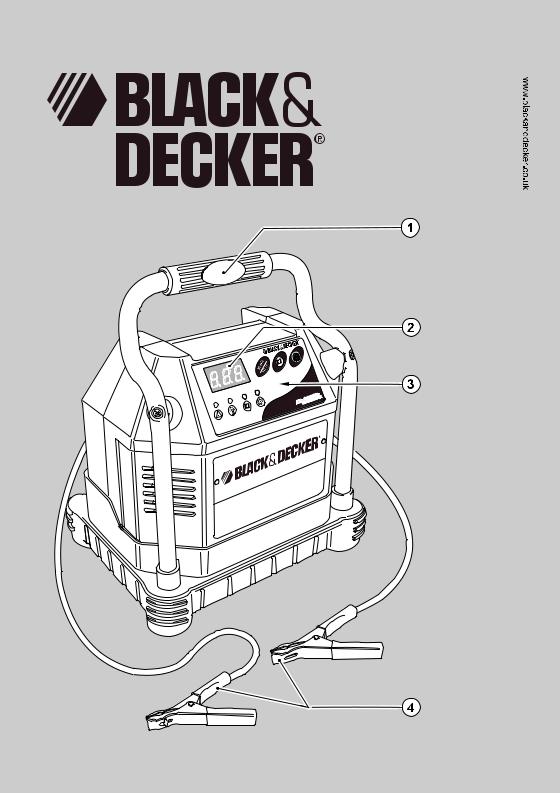Black & Decker BDV1084 User Manual

UK
Ireland
Australia
New Zealand

2

Intended use
Your Black & Decker battery charger is designed to charge lead-acid batteries. This product is intended for household, consumer use only.
Safety instructions
Warning! When using mains-powered appliances, basic safety precautions, including the following, should always be followed to reduce the risk of fire, electric shock, personal injury and material damage.
Read all of this manual carefully before using the appliance.
The intended use is described in this manual. The use of any accessory or attachment or the performance of any operation with this appliance other than those recommended in this instruction manual may present a risk of personal injury.
Retain this manual for future reference.
Using your appliance
Always take care when using the appliance.
This appliance is not intended for use by young or infirm persons without supervision.
The appliance is not to be used as a toy.
Use in a dry location only. Do not allow the appliance to become wet.
Do not immerse the appliance in water.
Do not open body casing. There are no user-serviceable parts inside.
Do not operate the appliance in explosive atmospheres, such as in the presence of flammable liquids, gases or dust.
To reduce the risk of damage to plugs and cords never pull the cable to remove the plug from a socket outlet.
After use
When not in use, the appliance should be stored in a dry, well ventilated place out of the reach of children. Children should not have access to stored appliances. When the appliance is stored or transported in a vehicle it should be placed in the boot or restrained to prevent
movement following sudden changes in speed or direction.
Inspection and repairs
Before use, check the appliance for damaged or defective parts. Check for breakage of parts, damage to switches and any other conditions that may affect its operation. Do not use the appliance if any part is damaged or defective.
Have any damaged or defective parts repaired or replaced by an authorised repair agent.
Never attempt to remove or replace any parts other than those specified in this manual.
Power cord safety
Warning! Never alter the ac power cord or plug. If it will not fit, have a proper outlet installed by a qualified electrician. Improper connection may result in an electric shock.
Specific safety instructions for battery chargers
The following symbols are marked on the appliance:
This appliance is double insulated; therefore no earth wire is required. Always check that the
power supply corresponds to the voltage on the rating plate.
Read these instructions before use:
If the supply cord is damaged, it must be replaced by the manufacturer or an authorised Black & Decker Service Centre in order to avoid a hazard.
Never attempt to charge non-rechargeable batteries. Have defective cords replaced immediately.
Do not expose the battery charger to water. Do not open the battery charger.
Do not probe the battery charger.
Never allow the red and black battery clamps (4) to touch each other or another common metal conductor. This could cause damage to the appliance and/or create a spark/ explosion hazard.
Always store the battery clamps (4) in the storage provided when not in use.
Batteries
Warning! Never attempt to charge a frozen battery.
Under extreme conditions, battery leakage may occur. When you notice liquid on the batteries, carefully wipe the liquid off using a cloth. Avoid skin contact.
In case of skin or eye contact, follow the instructions below. Warning! Battery fluid is a diluted sulphuric acid and may cause personal injury or damage to property. In case of skin contact, immediately rinse with water. If redness, pain or irritation occurs seek medical attention. In case of eye contact, rinse immediately with clean water and seek immediate medical attention.
When disposing of batteries, follow the instructions given in the section "Protecting the environment".
Add distilled water in each cell until the battery acid reaches the level specified by the battery manufacturer. This helps to purge excess gas from the cells. Do not overfill. For a battery without cell caps (maintenance free), carefully follow the manufacturer's charging instructions.
Study all the battery manufacturer's specific precautions, such as removing or not removing cell caps while charging, and the recommended charging rates.
3 |

Make sure that the initial charging rate does not exceed the battery manufacturer's requirement.
Warning! Risk of explosive gas mixtures. Working in the vicinity of a lead-acid battery is dangerous. Batteries generate explosive gases during normal battery operation. For this reason, it is of utmost importance that each time, before using your battery charger, you read this manual and follow the instructions exactly.
Use of an attachment not recommended or sold by Black & Decker may result in a risk of fire, electric shock, or injury to persons.
An extension cord should not be used unless absolutely necessary. Use of an improper extension cord could result in a risk of fire and electric shock, and will void the warranty.
Personal safety
Wear complete eye protection and suitable clothing to give protection from contact with battery fluid.
Avoid touching the eyes while working with a battery. Acid, acid particles or corrosion may get into the eyes.
Remove personal metal items such as rings, bracelets, necklaces and watches when working with a lead-acid battery. A lead-acid battery can produce a short circuit current high enough to cause a severe burn.
Be extra cautious to reduce the risk of dropping a metal object onto the battery. This might cause sparks or shortcircuit the battery or other electrical part, which can cause an explosion.
Preparation before charging
The appliance must only be connected to a 12 V lead-acid battery. Before charging, confirm that the voltage of the battery is 12 V by referring to the label on the battery or from the information available relating to its application e.g. car user manual.
Do not use the appliance for charging dry-cell batteries that are commonly used with home appliances. These batteries may burst and cause injury to persons and damage to property.
Warning! Explosive gas may be vented from lead acid batteries when charging. Make sure that the area is well ventilated and remove any sources of ignition when conducting charging procedures.
Position the battery charger as far away from the battery as the leads will allow. The battery charger contains switches that may create a spark.
Do not place the battery charger above or stand the battery charger on top of the battery.
Explosive gases may collect near the ground. Locate the battery charger as high as possible above ground level. Do not use power tools in the charging area.
Do not smoke or have naked flames in the charging area. Follow the instructions for connecting and disconnecting the battery charger leads or battery terminals.
A marine (boat) battery must be removed and charged on shore. To charge it on board requires equipment specially designed for marine use. This appliance is NOT designed for such use.
Vehicles may have electrical and electronic systems (e.g. engine management systems, mobile phones) that may be damaged if subjected to high starting voltages and voltage peaks. Before connecting the appliance to the vehicle, read the vehicle's owner's manual to confirm that external charging is allowed.
Follow these instructions and those published by the battery manufacturer and vehicle manufacturer.
Only connect and disconnect the dc output clamps after removing the supply cord from the electric outlet. Never allow clamps to touch each other.
Check the polarity of the vehicle battery terminals before connecting the appliance. Always disconnect the negative (black) cable first: followed by the positive (red) cable.
When charging a battery installed in the circuit follow the manufacturers instructions for accessing the battery and the following:
Do not charge the battery while the engine is operating. Be aware that engine components e.g. the coolant fan may start automatically. Keep hands and body away from engine components and position the battery charger and cables to prevent contact.
Make sure that the battery charger and the cables are located to prevent damage from closure of doors and engine compartment covers.
Make sure that the connections can be made without touching the metal body or components adjacent to the battery.
When using this appliance in proximity to the vehicle's battery and engine, stand the appliance on a flat, stable surface and be sure to keep all clamps, cords, clothing and body parts away from moving parts of the vehicle.
If it is necessary to remove the battery from the vehicle to charge or to clean the terminals, make sure that all accessories in the vehicle are switched off, so as not to cause a spark.
To reduce the risk of electric shock, disconnect the appliance from any power source before attempting maintenance or cleaning. Turning off controls without disconnecting the appliance will not reduce this risk.
Connecting the battery charger
When all the preparations for charging and personal safety have been completed, proceed as follows:
4 |
